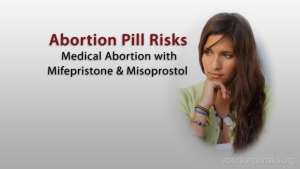Home
ABORTION PILL RISKS
Just the Facts
"No woman should risk her health or life because she lacks factual and accurate medical abortion information to make a well-informed decision when terminating an early pregnancy with Mifepristone and Misoprostol."
UNDERSTANDING THE RISKS
Unintended Pregnancy in the U.S
The United States has one of the highest unintended pregnancy rates among developed countries. (1)
- At least 45% of all American women will experience an unintended pregnancy. (2)
- Nearly 40% off all unintended pregnancies are terminated by abortion (2)
- 19% of all pregnancies in 2014 (excluding miscarriages) end in abortion (2)
Medical Abortion Growth
Mifepristone has increasingly become an integral part of abortion provision in the United States and likely has contributed to a trend toward very early abortions. (3)
The number of early medical abortions and the proportion of all abortions accounted for by this method have grown substantially. Mifepristone use has grown steadily since its introduction in the United States in 2000, and substantially in recent years. (4)
Health Risks
The continuing increase in the number of medical abortions performed each year and the risk of major health complications is of great interest to patients and health care providers. (5)
Patients may experience adverse events that can range in severity from complications that are serious and life-threatening to those that can lead to hospitalization or death. (6)
Medical abortion may be new and unfamiliar to many women. A woman making an abortion decision needs to understand the risks, benefits, and options available that is in the best interest of her health, safety and welfare.
Abortionpillrisks.org
The Mission
This site will strive to help educate women and the public using factual information about medical abortion health risks associated with mifepristone and misoprostol for early pregnancy termination.
Just The Facts
Information referenced in this site is derived from the United States Food and Drug Administration's (FDA) website, U.S. Government publications, reproductive health resources, medical abortion provider publications, and international medical and research journals.
REFERENCES
1. Homco, Juell B, et al., et al. Reasons for ineffective pre-pregnancy contraception use in patients seeking abortion services. Contraception Journal. December, 2009, Vol. 80, 6, Pages 569-574.
2. Guttmacher Institute. Facts on Induced Abortion in the United States, January 2017: Fact Sheet. Guttmacher Institute. [Online] May 2017. [Cited: May 27, 2017.] https://www.guttmacher.org/fact-sheet/induced-abortion-united-states.
3. Jordan, Beth and Shields, Wayne C. Happy anniversary mifepristone: a decade of promise and challenges. Contraception Journal. September, 2010, Vol. 82, 3, Pages 219-220 .
4. Jones, Rachel K, et al., et al. Abortion in the United States: Incidence and Access to Services, 2005. Guttmacher Institute, Perspectives on Sexual and Reproductive Health. [Online] March 2008. [Cited: September 15, 2011.] http://www.guttmacher.org/pubs/journals/4000608.html. DOI:10.1363/4000608.
5. Niinimäki, Maarit, et al., et al. Immediate Complications After Medical Compared With Surgical Termination of Pregnancy, Obstetrics & Gynecology, 114(4):795-804. NCBI, PubMed. [Online] October 2009. [Cited: September 20, 2011.] http://www.ncbi.nlm.nih.gov/pubmed/19888037. PMID: 19888037.
6. PBS. Frontline, Dangerous Prescription,The FDA: Hazardous to Your Health?, Interview: Paul Seligman, M.D.,M.P.H. PBS.org, WGBH educational foundation. [Online] November 13, 2003. [Cited: August 16, 2011.] http://www.pbs.org/wgbh/pages/frontline/shows/prescription/interviews/seligman.html.
Page Last Updated: 5/27/2017



Comments on this entry are closed.